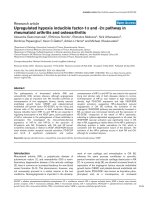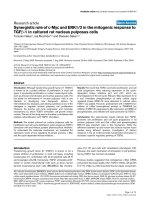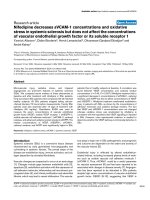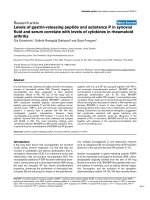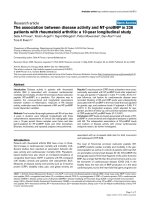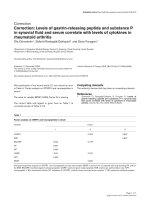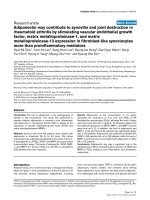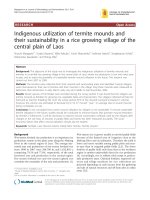Báo cáo y học: " AIDS epidemic at age 25 and control efforts in China" ppsx
Bạn đang xem bản rút gọn của tài liệu. Xem và tải ngay bản đầy đủ của tài liệu tại đây (189.49 KB, 3 trang )
BioMed Central
Page 1 of 3
(page number not for citation purposes)
Retrovirology
Open Access
Commentary
AIDS epidemic at age 25 and control efforts in China
Yiming Shao*
Address: National Center for AIDS/STD Control and Prevention, Chinese Center for Disease Control and Prevention, 27 Nanwei Road, Xuanwu
District, Beijing, China
Email: Yiming Shao* -
* Corresponding author
Abstract
In the first 10 years of AIDS epidemic in China, intravenous drug users (IDUs) and Former Plasma
Donors (FPDs) were hardly hit in the late 1980s and mid 1990s respectively. In the last 10 years,
while IDU epidemic keeps at a fast pace, sexual transmitted cases of HIV have been steadily
increasing. All signs indicate that the HIV epidemic in China is at a turning point, spreading from
high risk groups to the general population. Learning from the SARS epidemic, China has recently
launched an impressive AIDS campaign by making serious political commitments, and by
strengthening the public health system and implementing an aggressive Four Free One Care Policy.
There remains huge challenges both at the societal level which form the roots of the AIDS epidemic
and at increasing the capabilities of the implementation teams. In addition to other needed efforts,
enhancing AIDS research through international collaborations will strengthen China's ability to
conduct her huge control program efficiently. Only with a scientific approach and evidence-based
strategy, can China seize the opportunity to stop AIDS at an early stage.
The history and current status of the HIV/AIDS
epidemic in China
China reported its first HIV/AIDS cases among hemophil-
iac patients in Zhejiang province in 1985 [1]. In the same
year, a foreigner was diagnosed with AIDS in Beijing [2].
There were a few isolated cases of HIV/AIDS identified
sporadically but the first HIV epidemic in China was not
discovered until 1989 when 146 HIV-positive cases were
found among intravenous drug users (IDUs) in Ruili,
China's border town with Myanmar in Yunnan province
[3].
In the early 1990s, the epidemic was mainly along the
southwest border regions where more than two-thirds of
China's total reported cases of HIV/AIDS originated. The
majority of affected people were IDUs, who accounted for
about 70% of the country's total reported cases [4]. In the
mid-1990s, while the HIV epidemic in border regions
slowly spread to nearby regions and inland China, plasma
collection activities in central China such as Henan and
surrounding provinces caused large numbers of commer-
cial plasma donors to become infected with HIV through
infusion of pooled contaminated blood cells [5-7]. The
HIV infections among the plasma donor population trig-
gered the second wave of HIV/AIDS epidemic in China.
Thereafter a continuous spread of HIV infections among
IDU populations persisted. By then, all provinces had
reported HIV/AIDS cases, and the epidemic entered a
rapid growth phase [4]. The unique characteristics of
China's AIDS epidemic in the 1990s were the following:
1) injected drug users and former plasma donors were the
two major groups affected by the epidemic, 2) most of the
infected patients were young males, and 3) the majority of
them lived in rural areas [4].
Published: 01 December 2006
Retrovirology 2006, 3:87 doi:10.1186/1742-4690-3-87
Received: 22 November 2006
Accepted: 01 December 2006
This article is available from: />© 2006 Shao; licensee BioMed Central Ltd.
This is an Open Access article distributed under the terms of the Creative Commons Attribution License ( />),
which permits unrestricted use, distribution, and reproduction in any medium, provided the original work is properly cited.
Retrovirology 2006, 3:87 />Page 2 of 3
(page number not for citation purposes)
The large scale blood contamination events among
plasma donors were quickly controlled within a short
period of time after they were discovered [7]. However,
the HIV epidemic among the IDU population remained at
fast pace and spread to many parts of the country. There
was a steady increase of HIV infections among promiscu-
ous groups in several regions of the country between the
late 1990s and early 2000s [8]. The trend of HIV spread in
China from high risk groups to the general populations
occurred mainly through sexual transmission [8]. Accord-
ing to the joint report by the Ministry of Health, UNAIDS,
and WHO, by the end of 2005, there were approximately
650,000 people living with HIV/AIDS in China, among
which 75,000 are AIDS patients [9]. New HIV cases are
being transmitted primarily through intravenous drug use
and risky sexual behavior, indicating that HIV is spreading
from the high risk groups to general populations, particu-
lar in areas where the epidemic started early [9]. These are
all dangerous signs that this terrible disease will expand
rapidly unless effective control measures are taken imme-
diately. An early projection predicts 10 millions HIV/AIDS
cases in China by 2010 in the absence of effective control
measures. The national AIDS control target is set to pre-
vent 85% of potential new HIV/AIDS cases in order to
keep the total number below 1.5 millions in China by
2010 [10].
The social roots of AIDS epidemic in China
The HIV/AIDS epidemic in China has deep roots in a
weakened social structure as well as a health infrastructure
which are the products of economic reforms from the past
two to three decades. Understanding the root causes of
these problems is key to finding long-term, effective solu-
tions. For one thing, AIDS must not be treated simply as a
medical problem. Social roots for the spread of AIDS
include unbalanced development between eastern and
western regions of the country; poverty; huge mobile pop-
ulation; inadequate investment in public health; as well as
social problems such as drug abuse and prostitution. The
most seriously hit population and regions are where
social and public health problems are rampant rendering
a large number of people vulnerable to infectious dis-
eases. In China, the AIDS epidemic is predominantly
among farmers in underdeveloped southwest and north-
west border regions as well as inland agricultural prov-
inces. It has been debated in China whether the
government should or should not bear the responsibility
of providing treatment to AIDS patients. For many years,
the AIDS control program in China had only a prevention
arm, without treatment and care components. There was
no incentive for people to go in for testing, and many peo-
ple living with HIV/AIDS hid in fear of discrimination.
Breakthrough in China's AIDS policy
The SARS epidemic in 2003 was a wake-up call for the
Chinese government and society as a whole. It has now
been widely recognized that public health is not merely a
medical issue but rather a security issue, affecting eco-
nomic growth and social stability. On World AIDS Day
2003, Premier Jiabao Wen announced a new national
AIDS control policy, "Four Frees and One Care" (free
treatment, free Voluntary Counseling and Testing (VCT),
free Prevention of Mother to Child Transmission (PMCT)
and free schooling for AIDS orphans, and provision of
social relief for HIV patients). By the end of 2005, 20,453
AIDS patients were receiving antiretroviral therapy in 605
counties within 28 provinces. The policy was a break-
through for China's AIDS control program and had a pro-
found impact even far beyond the AIDS field. The new
policy reconnects prevention and treatment, long lost
chain in AIDS control work in China. With the govern-
ment providing free testing and treatment, people living
with HIV/AIDS and people at risk are now voluntarily
seeking testing and collaborating more frequently with
health care workers. Since the adoption of the new policy,
there has been a two-fold increase in newly detected cases
of HIV/AIDS. In the meantime, more than twelve thou-
sand patients have been treated, and thousands of lives
have been saved.
Current challenges and prospects for future
There are many challenges facing China in implementing
the Four Frees and One Care policy and other new initia-
tives. Bottlenecks impeding rapid and effective implemen-
tation of AIDS control programs are no longer political or
financial issues. Rather, the greatest problem is the lack of
technical capacity, in particular, a shortage of well-trained
public health professionals who can manage large scale
programs as well as experienced clinical teams who can
provide care to patients in rural areas. Even though many
early stage HIV/AIDS cases have been identified due to
large scale screening programs in the last two years [9],
only about 20% of the country's total HIV/AIDS cases are
known. Most AIDS patients are in rural areas where med-
ical resources are few and technical capacity is very weak.
There are few experienced doctors who are capable of
determining toxicity level of HIV/AIDS treatment and
adjusting treatment regime accordingly [12]. There is also
an urgent need to improve patients' adherence in order to
prevent emergence and circulation of drug resistant HIV
strains [10,11]. Currently, China has technical capacity to
produce only five generic versions of antiretroviral drugs
[12]. Consequently, AIDS treatment programs are forced
to purchase expensive brand name drugs for first line Anti-
Retroviral (ARV) treatment, and thus options for procure-
ment of cost-effective second line drugs need to be
explored.
Publish with BioMed Central and every
scientist can read your work free of charge
"BioMed Central will be the most significant development for
disseminating the results of biomedical research in our lifetime."
Sir Paul Nurse, Cancer Research UK
Your research papers will be:
available free of charge to the entire biomedical community
peer reviewed and published immediately upon acceptance
cited in PubMed and archived on PubMed Central
yours — you keep the copyright
Submit your manuscript here:
/>BioMedcentral
Retrovirology 2006, 3:87 />Page 3 of 3
(page number not for citation purposes)
The recent policy breakthrough and new initiatives on
AIDS have shown that the Chinese government is fully
committed to solving today's public health problems like
it did in the 1950s to 1970s. Public health being high on
the political agenda has led to significant funding
increases and mobilization of public health agencies and
local communities. As a result, one can be confident that
the AIDS epidemic will be effectively controlled in China
in the same way as her past successful history of control-
ling other infectious diseases. At the same time, what
remains concerning is that the national context has
changed from a planned economy to a market economy
in today's China. Novel disease control measures suitable
to the current social and economic structures need to be
developed. This can only be achieved through focused
research efforts with large groups of scientists specializing
in both basic and applied research. China's AIDS research
infrastructure is still not adequately established. In ARV
treatment and many other AIDS research areas, Chinese
researchers have limited experience. Therefore, interna-
tional collaboration in AIDS research is urgently needed
to build up and strengthen China's AIDS research infra-
structure. Most of the current international AIDS pro-
grams in China do not have a research component. We
should encourage both Chinese and international AIDS
researchers to work more closely together in the future.
Their research collaboration will help China formulate
evidence-based treatment, prevention, and control strate-
gies, which can be the bedrock for long-term, effective
management of China's national AIDS control programs.
References
1. Zeng Y, Fan J, Zhang Q, Wang PC, Tang DJ, Zhon SC, Zheng XW, Lin
DP: Detection of antibody to LAV/HTLV-III in sera from
hemophiliacs in China. AIDS Res 1986, 2(Suppl1):S147-9.
2. . Nov 30 2005
3. Ma Y, Li Z, Zhao SD: HIV infected people were first identified
in Intravenous drug users in China. Chin J Epidemiol 1990,
11:184-185.
4. Department of Disease Control, Minister of Health China, National
Center for AIDS Prevention and Control, Group of National HIV
Sentinel Surveillance: National sentinel surveillance of HIV
infection in China from 1995 to 1998. Chin J Epidemiol 2000,
21:7-9.
5. Zheng X, Wang Z, Xu J, Huang S, Wang C, Li Z, Wang L, Zhang G,
Gao M, Li H, Qu S, Cui W, Li X, Wei W: The epidemiological
study of HIV infection among paid blood donors in one
county of China. Chin J Epidemiol 2000, 21:253-255.
6. Zhuang K, Gui X, Su B, Tien P, Chen Z, Zhang L: High prevalence
of HIV infection among women and their children in Henan
Province, China. JAIDS 2003, 33:649-650.
7. Zheng X: Control of transmission of HIV among drug users
and commercial blood donors. Chin J Epidemiol 2000, 21:6-6.
8. State Council AIDS Working Committee Office and UN Theme
Group on HIV/AIDS in China: A Joint Assessment of HIV/AIDS Preven-
tion, Treatment and Care in China (2004) . December 1, 2004
9. Wu Z, Sun X, Sullivan SG, Detels R: HIV testing in China. Science
312:1475-1476. 9 June 2006
10. The Ministry of Health, National Development and Reform Commis-
sion, The Ministry of Science and Technology, and The Ministry of
Finance of People's Republic of China: Chinese Middle and Long Period
AIDS Prevention and Control Programme (1998–2010) . Oct 26, 1998
11. Xing H, Jiang S, Si X, Cheng H, Shang H, Li J, Kang L, Zhong P, Shao
Y: HIV-1 drug resistance in China: nation-wide survey and
analysis of impacting factors in the national ARV treatment
program. TuPp0302, 3rd IAS conference on HIV Pathogenesis and
Treatment, July 2005, Rio de Janeiro .
12. The Ministry of Health of the People's Republic of China, Joint United
Nations Programme on HIV/AIDS and World health Organization:
2005 Update on the HIV/AIDS Epidemic and Response in China . January
24, 2006

